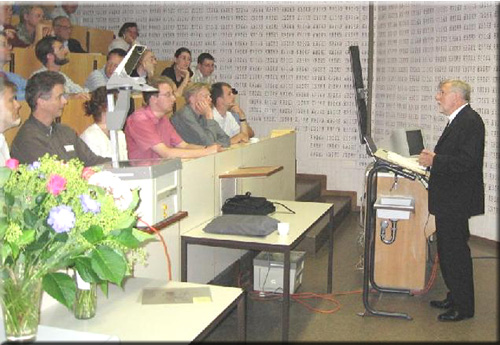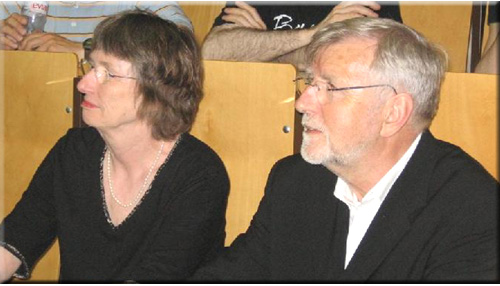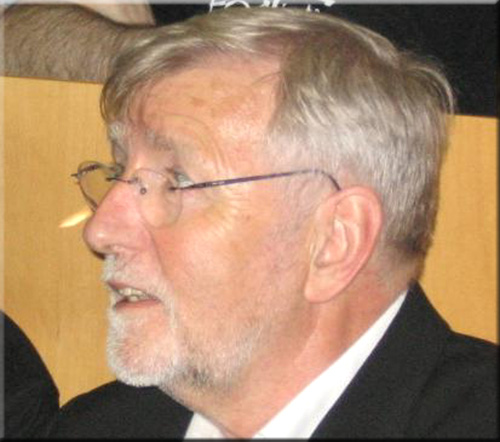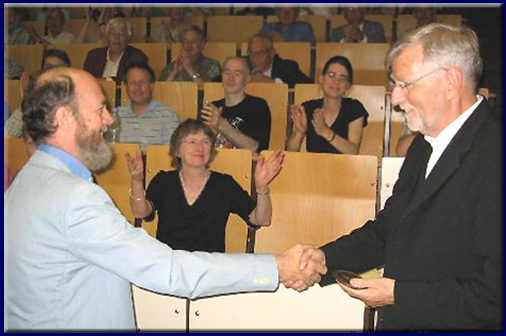Henk Bos Valedictory Symposium
The symposium was focused around the retirement of Henk Bos as full professor of History of Mathematics on July 1, 2005.

Henk Bos giving his valedictory lecture
Details of the Symposium
The symposium was opened by Jan Hogendijk, who called attention to the ICHM sponsorship. The first speaker was Annette Imhausen (Cambridge, UK). In her lecture, entitled "Administration, Education, Representation: The Various Uses of Mathematics in Ancient Egypt," Dr. Imhausen presented a survey of the different periods of the history of ancient Egypt, the types of surviving mathematical evidence, and the conclusions which can be drawn on the mathematical activities in each period. The fragmentary nature of the evidence was marvellously illustrated.
After the lunch break, Volker Remmert (Mainz, Germany) gave a presentation entitled "Antiquity, Nobility and Utility: Picturing the Mathematical Sciences in the Early Modern Period." Using illustrations from mainly frontispieces of sixteenth- and seventeenth-century mathematical works, the speaker took the audience on a recreational tour through the "garden of mathematics." Remmert discussed the iconography of ancient and early modern mathematicians and astronomers (all males), and of mathematics and her branches (arithmetic, geometry, stereometry etc.), all depicted as females, as well as the messages implied in this iconography.
The high point of the symposium was the traditional "afscheidscollege" (retirement lecture) by Henk Bos, titled "Loose Ends." In his lecture, Henk Bos examined the Leibnizean concept of "infinitangular polygon" as an example of a "fluid concept." A fluid concept is a concept which cannot be precisely defined and which may be self-contradictory. Important key concepts in history of mathematics are fluid concepts. These concepts cannot be precisely reconstructed from the surviving sources and cannot be exactly analyzed in modern mathematical terms. The fact that some of the important basic concepts in mathematics are fluid concepts is an argument against the supposed unshakable truth of mathematics.
The valedictory lecture was immediately followed by "Unconcluding remarks" by Jeremy Gray (Milton Keynes, UK). Gray began with an analysis of Henk Bos' historical metholodology, which then turned into a ceremony in which the Kenneth O. May Medal was presented to Henk Bos.



Jeremy Gray presenting the fifth Kenneth O. May Medal to Henk Bos
In 1989, the International Commission for the History of Mathematics awarded for the first time the Kenneth O. May Prize in the History of Mathematics. This award honors the memory of Kenneth O. May, mathematician and historian of mathematics, who was instrumental in creating a unified international community of historians of mathematics through his tireless efforts in founding in 1971 the International Commission for the History of Mathematics and in 1974 the ICHM's journal, Historia Mathematica. The Kenneth O. May Prize has been awarded every four years since 1989 to the historian or historians of mathematics whose work best exemplifies the high scholarly standards and intellectual contributions to the field that May worked so hard to achieve. To date, the following distinguished historians of mathematics have been recognized for their work through receipt of the Kenneth O. May Prize, which includes a medal cast in bronze and designed by the Canadian sculptor, Salius Jaskus:
- 1989, Dirk J. Struik (United States) and Adolf P. Yushkevich (Soviet Union)
- 1993, Christoph J. Scriba (Germany) and Hans Wussing (Germany)
- 1997, René Taton (France)
- 2001, Ubiratàn D'Ambrosio (Brazil) and Lam Lay Yong (Singapore).
On behalf of the International Commission for the History of Mathematics, it is my great pleasure to present the 2005 Kenneth O. May Prize and Medal to Henk Bos (The Netherlands).
Henk Bos earned his Ph.D. from Utrecht University in 1973 for a dissertation entitled "Differentials, Higher Order Differentials and the Derivative in the Leibnizian Calculus." This major study, which appeared in the Archive for History of Exact Sciences under that same title in 1974, was the first to draw attention to, and explain, what Leibniz's differentials actually are and how they were used; in so doing, it illuminated several otherwise puzzling features of the Leibnizian calculus.
By 1981, Bos's research interests had shifted to the roles of geometry and algebra in the work of Descartes. In that year, he published another major work "On the Representation of Curves in Descartes' Géométrie" and then three years later yet another fundamental study on "Arguments on Motivation in the Rise and Decline of a Mathematical Theory: The 'Construction of Equations,' 1637-ca. 1750," both again in the Archive for History of Exact Sciences. It is not, however, the careful reading of all of Descartes's relevant writings that makes these works stand out (although selective readings are the norm). Nor is it the attention to the decline of a mathematical theory that is particularly noteworthy in Bos's research, although that too is unusual in a field often given over to the celebration of accomplishment. Rather, it is the steady force of his critical intellect that makes his research exceptional. He took a subject—the invention of Cartesian geometry, which most historians of mathematics thought they knew—and showed that they did not know it. He accomplished this in the best historical tradition, namely, by reading the historical texts carefully on their own terms. He examined Descartes's conceptions both of a curve and of how properly to answer geometrical questions. He then showed how these conceptions governed the formation of Descartes's remarkable work and how they shaped considerations of such questions for a century. Finally, he documented how these ideas waned as the original rationale behind them ceased to convince.
This body of work earned Henk Bos a professorship of the history of mathematics in 1985 at Utrecht University where he has, indeed, spent his entire career. The very next year, in 1986, his work was again recognized when he was honored as an invited speaker at the International Congress of Mathematicians held in Berkeley, California. Many of the historical issues that he had addressed up to this point were collected in a book of essays, entitled Lectures in the History of Mathematics, which was published in 1993 and reprinted in 1997 in the HMATH series of the American and London Mathematical Societies. A volume well regarded by mathematicians, who find in him a trustworthy writer of mathematics, it has effectively extended Bos's audience beyond the community of historians of mathematics to the international mathematical community as a whole. These essays document a further feature of his work: the enormous pleasure he takes in what he writes about, and which he invariably conveys.
In 2001, Bos's long-awaited book, Redefining Geometrical Exactness: Descartes' Transformation of the Early Modern Concept of Construction, was published by Springer-Verlag. A work of exceptional distinction, it greatly extends and refines his earlier analysis of Descartes, in addition to considering seriously the responses that other scholars have made to his historical research. It looks at Descartes's contemporaries and immediate predecessors: Clavius, Viète, Kepler, and Fermat; it is deeply versed in the sources, as good history should be; yet, its most profound characteristic is its thoughtfulness. Bos gives to this seventeenth-century material the kind of careful attention it was given by the experts when it was new. It is an exploration of what counted as good mathematics in a particular period and is crafted, as its title suggests, around the concept of exactness. When is a mathematical description exact? What sorts of constructions are to be allowed? This is, dare one say, "exactly" the right question to ask. The result is a book that not only recaptures a major aspect of the mathematics of its time but also strongly suggests how much more good work can be done elsewhere in the history of mathematics provided the historian has the ability to ask such a good question and to pursue its answers so sensitively.
Henk Bos has, through his deep and insightful research, fundamentally shaped present-day understanding of the mathematics of the seventeenth century. It is for this accomplishment that the International Commission for the History of Mathematics is proud to present to him the 2005 Kenneth O. May Prize and Medal.